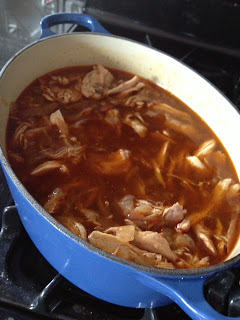The food of rural Texas (AKA my childhood) is all about making do with what you have. Long before all this "reduce, reuse, recycle" stuff, using up or going without has been bred into us native Texans for generations. If your family helped settle this land, you have genes that are resourceful and dare I say, "frugal" would be the nice word.
Chances are your grandpappy and mammy were at some point snowed in, surrounded by injuns (in the case of my paternal great-great-great-great
Uncle Tapley, Santa Anna's men down to the Alamo) or otherwise cut off from outside resources. Or just flat broke. So they used what they had. And every bit of it.
In the spirit of using whatever you have handy to your best advantage, I present Red Eye Gravy. As simple a recipe as you can get, Red Eye Gravy is what I could call an acquired taste. It was my father who always made it, and my brother who waited anxiously by the stove. I'm not a huge fan, but there's no doubt that its origins lie south of the Mason-Dixon and it's "use it up" qualities make it a Texas staple.
Red Eye Gravy is so named because of its deep red color, although its consistency makes it more of a sauce than a gravy. It's very thin and contains no thickening agents, so don't expect creamy. Serve it over
biscuits and pieces of pan seared ham. Some people like to add a fried egg or two.
Start with a ham. Please do not substitute bacon just because it's pork. Bacon will yield a greasy mess and likely injure you in the process. I used a ham steak because good Lord, what would I do with an entire ham?
If you have a ham, cut off pieces about 1/8" thick--this is not the time to go deli thin--and 4" squareish. If you have a ham steak, you might want to slice it into two thinner pieces once you have the thing cut up into the 4" chunks. I'd use about 1-1 1/2 pounds.
 |
| The technical term for the caramelized bits is "drippings." |
Heat a skillet (I used non-stick, but really, it's better if you don't, and I wish I hadn't) and cook the ham pieces over low heat a few minutes on each side until you get a most delightful red. It's important not to add any grease or oil and just as important not to cook the ham too quickly. You're not so much frying as you are coaxing the juice from the ham and hoping that little caramelized bits of fat and juice cling to the pan. See?
Transfer your cooked ham to a plate and get about 1/4 of a cup of coffee. The coffee can be freshly made, hot or cold, but here is where the Old Timers used what they had. Back in the day, people did not pay $5 for a cup of coffee, did not buy coffee in any flavor but STRONG, did not brew fresh every day and sometimes even reheated and drank coffee left over from the previous day. In my 1970's childhood, you made coffee in a
percolator, and you made a lot of it because it was a PITA to assemble the contraption and the stupid thing took so long to make a pot.
But freshly brewed is okay. However,
please do not use flavored coffee. Do not use fancy coffee of any kind. I'm talking you should straight up get some Folger's. Trust me on this, even the non-fanciest coffee you already have in your pantry is not right for this recipe. It will taste FUNKY.

Your heat should be low from cooking the ham, but now turn it up to low-medium. Take your plain old I-wouldn't-actually-drink-this coffee and add it to the pan. The pan will bubble and look mildly like a science experiment for a few glorious moments, but never fear, because there is so little grease in the pan, it will not explode or even splatter. Another reason why bacon is verboten here.
Take a spatula and stir to remove the drippings from the pan. When I first mentioned Red Eye Gravy to my friend, Jersey, she was startled by the use of coffee to "deglaze" the pan. Deglaze? It never occurred to me that that this process was deglazing. You're just getting the drippings.
 |
| Come on, it's going to get cold. |
Anyhoo, stir and scrape and add up to 1/4 cup of water if it seems too dark and let it cook for about two more minutes. It will not thicken. I find the taste a little strong, so you can add a tablespoon of brown or white sugar if you like.
Assemble your plate. You will need biscuits--and again, it matters not if they are fresh or hot or cold. In fact, this is an Old Timer's trick to use up day (or several day) old biscuits. Arrange your ham and biscuits on a plate and pour on your gravy.
Enjoy and rest assured that Uncle Tapley likely ate his fair share of Red Eye Gravy before giving his life for the Republic.
































